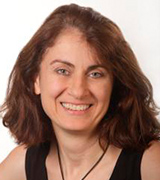Maria Drangova
 Scientist
Scientist
Why I Became a Scientist
Early in my undergraduate studies, I had the opportunity to work in a research laboratory where I learned that I could use my knowledge in engineering and physics to contribute to improving healthcare. I was fascinated by the prospect of continuous learning, working with inventive people and ultimately training the next generation of scientists. What I didn’t know was how truly diverse and challenging a career in science can be; I continue to enjoy the freedom and opportunity to be creative.
Research Summary
My research focus is in the area of cardiovascular imaging – my group develops imaging techniques that have implications in both basic research and clinical arenas, using computed tomography or magnetic resonance imaging.
Medical researchers are very active in developing new ways to treat cardiovascular diseases, and many of these new techniques are developed and tested in small laboratory animals (such as mice and rats), long before they are used in humans. One problem with this type of research is that there are few ways to assess the health of an animal’s heart, without killing it. We believe that it will be extremely useful for researchers to be able to assess the condition of the heart and vessels in live rodents, during research studies, and are developing such techniques using a new type of computed tomography (CT). We are also identifying new ways to enhance the contrast between different tissues, again to help in basic research studies of cardiovascular disease.
In the clinical arena, I work with cardiologists and engineers toward developing better ways to identify disease and deliver therapy more effectively. One such area is the treatment of electrophysiological diseases of the heart. RF ablation treatment is usually performed using a catheter that is maneuvered in the left atrium and requires tremendous expertise; procedure times are long – 3 hours or more. Although the treatment is effective in approximately 65-70% of patients, many must return for repeat procedures because the ablation of the tissues did not completely resolve the rhythm disorder. Most often this happens because some tissues were not completely ablated and some regions were missed entirely. The goal of our work is to use 3D images of the patient’s heart to develop techniques that reduce procedure times and the requirement for repeat ablations. We are working to achieve this by developing patient-specific devices, robotic navigation of the ablation catheters, as well as ways of improving the guidance of the procedure.
Lastly, my group is investigating better ways to track subject motion in MRI. Subject motion remains an important problem in magnetic resonance imaging – voluntary or physiologic motion causes blurring and other artifacts in the images. Currently, there is a technique called a “navigator” that is used during the acquisition of the image that can correct for motion in one dimension. Our group has been working on developing a three-dimensional “navigator” to allow motions in all dimensions to be detected simultaneously. The success of this work will lead to the ability to monitor and correct for three-dimensional translation and rotation of the head, heart, and other organs in real time.
Education
- Ph. D. Department of Medical Biophysics, University of Western Ontario (1993)
- Ph.D. in Biochemistry, University of Western Ontario
Training
- Post Doctoral Fellowship Stanford University, Stanford, California (1993-1996)
Awards
- Career Investigator Award, Heart and Stroke Foundation of Ontario (2007-2012)
- Scholarship, Medical Research Council of Canada (1998-2003)
- Fellowship, Medical Research Council of Canada (1993-1996)
- Research Fellowship - Heart and Stroke Foundation of Canada (declined) (1993)
Publications
Contact Info
Robarts Research Institute
Western University
London, Ontario
N6A 5B7
Phone: 519-931-5777 ext. 24064
Fax: 519-931-5260
Email: mdrangova@robarts.ca
Email: acarden6@uwo.ca








